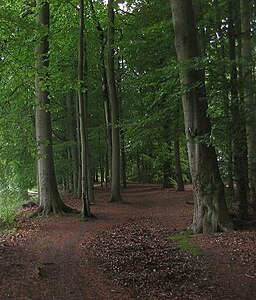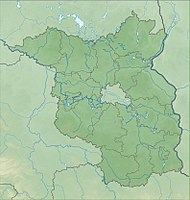Tiergarten (New Mill)
|
Zoo
|
||
|
Tiergarten, riverside path on the Staabe |
||
| location | Königs Wusterhausen , Dahme-Spreewald district , Brandenburg , Germany | |
| Area / extent | 155.47 ha / 3 km | |
| Identifier | 1197 | |
| WDPA ID | 165895 | |
| Natura 2000 ID | DE3747302 | |
| FFH area / extent | 153.26 ha / 3 km | |
| Geographical location | 52 ° 17 ' N , 13 ° 39' E | |
|
|
||
| Setup date | October 10, 1995 | |
| administration | State Environment Agency Brandenburg (Department of Ecology, Nature Conservation, Water) | |
| Legal basis | Directive 92/43 / EEC | |
The zoo is a recreation and nature reserve in Königs Wusterhausen , Dahme-Spreewald district , Brandenburg . The core of the oak forest lies in the Neue Mühle residential area on the banks of the Staabe (part of the Dahme ) and the Dahme bulge Krimnicksee , which merges into the Krüpelsee to the east . The zoo emerged from a historical hunting ground .
history
To the east of his hunting lodge in Wusterhausen , the "Soldier King" Friedrich Wilhelm I had a zoo laid out for hunting in a 900 hectare wooded area in 1725 . In the jungle-like area different gates secured the existence of the red , fallow deer and wild boar . In 1749 enclosures for partridges and pheasants were added. The breeding animals should enrich the table of Friedrich Wilhelm I, who held the famous tobacco colleges in the castle . In 1800 the zoo became part of the palace gardens.
After the last gates were closed in 1918, the forest became a popular destination for Berliners. In 1930 the area with its up to 270 year old oaks was placed under nature protection for the first time . The remaining area, called the Tiergarten, has an area of around 100 hectares and lies in the triangle of the south bank of the Staabes and Krimnitzsee. A riverside path that includes the Husareneck headland at the transition from the lake to the Staabe, and several cross paths open up the area. An educational forest trail provides information about the fauna and flora of the region on a 1.5 km long circular path on the banks of the Staabe and Krimmnick lakes. It is supplemented by an educational tree path along old trees that are worthy of protection, on which boards provide information about the importance, age and origin of the respective tree species. There is also a barefoot path for visitors . Users are encouraged to feel the various natural materials such as sand, stones, bark mulch, but also wooden discs, moss and pine cones. The “tree telephone” is a horizontally placed tree trunk on which visitors can experience by knocking or scratching one of the cut surfaces how the sound is conducted through the trunk. It also serves to train your sense of balance.
In the zoo there is also a crossing over the Fanggraben, popularly known as the Haunted Bridge or Devil's Bridge . The building from the 18th century was widened during the construction work on the Chaussee in 1889 and served as a customs bridge until 1907. It is popularly said that strange noises can be heard at midnight. According to another legend, a drunk man fell into the trench, drowned there and has been up to mischief as a ghost ever since.
natural reserve
Natura 2000 and FFH areas
The NSG Tiergarten is part of the coherent European ecological network of special protection areas Natura 2000 . The profile of the Federal Agency for Nature Conservation (BfN) contains the following characterization for the 153.26 hectare FFH area under the number 3747-302:
"Forest complex of common oak-hornbeam, alder-ash and alder quarry forests with importance for cave dwellers, adjacent or included standing waters, wet meadows and flowing waters"
Nature reserve
The newly formed "Tiergarten Nature Reserve" has existed since October 10, 1995, with a total area of 158 hectares including the areas of Königs Wusterhausen, Senzig and Zeesen . These include, for example, the Krebssee with its ditch leading to the south and the catching ditch that drains the Zeesener See through the Senziger Luch to the Dahme. The regulation on the nature reserve contains as a protection purpose among other things
"[...] the preservation and development of the area [...] as a location of rare, threatened wild plant communities, especially the existing diversity of near-natural forest communities, including the peculiarities resulting from the historical uses of the area, the large reed beds, the lowlands populated alder and willow breaks, the near-natural running waters (including the trench) with pronounced bank plant communities; [...]. "
Among the endangered animal species, the ordinance names the protection of mammals and reptiles that are threatened with extinction and bound to aquatic habitats . Furthermore, the habitats of cave breeders and railings , which are bound to richly structured and large-scale wetlands , are to be preserved. Species such as bats , which are bound to the existence of near-natural forest complexes, and large butterfly species , which require border habitats between forest and open landscapes, are also the focus of the protective measures.
In the area, which is characterized by settlement pressure, wet meadows endangered by overexploitation and subsequent abandonment are to be revitalized. The measures are also intended to help secure the Dahmegewässer - Pätzer Seen biotope network .
Flora and fauna
plants


Among the habitat types of FFH fact sheet lists the following plants or forest communities on moor grass meadows (Natura 2000 Code 6410), humidity Hochstaudenfluren (6430; Convolvuletalia sepium , Glechometalia hederaceae and Filipendulion ), Old acidophilous oak forests on sandy soils with English oak (9190; birch Oak forest ), chickweed oak and hornbeam forests (9160; Stellario-Carpinetum ), hornbeam -beech forests (9110; Luzulo-Fagetum ), flowing waters with flooding aquatic vegetation (3260) and natural and near-natural nutrient-rich still waters with spawning or frog-bite communities (3150; Magnopotamion or hydrocharition ).
Animals
According to Annex II of the Flora-Fauna-Habitat Directive and the ordinance of the state, including their habitats that are important for reproduction, nutrition, migration and wintering, are particularly protected: among the mammals the otter ( Lutra lutra ) and among the fish the bitterling ( Rhodeus amarus ).
See also
literature
- Karl-Heinz Wollenberg: The "Tiergarten" nature reserve. Nature conservation in Dahmeland. Prieros, 1997.
Web links
Individual evidence
- ↑ Information according to the information board on site, as of May 2008 and according to Dahme-Seen Tourismus, tour of Königs Wusterhausen ( page no longer available , search in web archives ) Info: The link was automatically marked as defective. Please check the link according to the instructions and then remove this notice. (PDF)
- ↑ Information panel for the recreational forest Tiergarten - Königs Wusterhausen , inspection in February 2016.
- ↑ a b c 3747-302 Tiergarten. (FFH area) Profiles of the Natura 2000 areas. Published by the Federal Agency for Nature Conservation . Retrieved February 11, 2020.
- ↑ The Senziger Luch is referred to as a nature reserve on various maps, but as of May 2008 it is not included in the official lists of the State of Brandenburg, see also the list of nature reserves in Brandenburg
- ↑ a b Ordinance on the "Tiergarten" nature reserve of June 30, 1995 in the Brandenburg system of regulations (BRAVORS)




